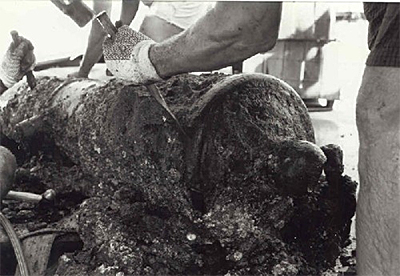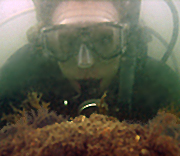
Cannon Recovery
As work progressed and one cannon was selected for recovery, SOAR began to involve the general public through articles, high school internships, and public talks.
The northernmost cannon had rolled away from the other seven during the wrecking process, and therefore was not encrusted to the other guns. This gun was selected for recovery as it could be done without disturbing the rest of the site. Three-inch nylon straps were placed around the cannon and brought together at one spot above the central balance point of the cannon. The cannon and its associated concretions were then directly lifted out of the water with a crane and taken to the site’s field conservation laboratory, kept in water the entire time. In addition to the fieldwork that was completed in 1998, SOAR also began archival research on the site. This included research at libraries in Florida, New York, Maryland, Virginia, and the Library of Congress in Washington D.C. Attempts were made to determine the identity of the wreck site. Early research focused on the slave ship General Nicholls which sank in 1797, but this did not prove correct. Public archaeology associated with the site also began in 1998. SOAR sought to reach the people of the St. Augustine area through public talks, newspaper, newsletters, journal articles, and TV. An internship was also set up for local high school students to offer them a chance to not only work on the site, but to get a general training in museum studies, nautical archaeology, and public interpretation in the form of exhibits and displays. An exhibit was set up at the St. Augustine Lighthouse and Museum to incorporate both information on the site, as well as artifacts that had already been recovered. In 1999 the Lighthouse Archaeological Martime Program (LAMP)was founded as the formal research arm of the St. Augustine Lighthouse & Museum. LAMP sponsored additional fieldwork on the Industry site after 1999.
Previous Next

